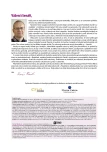Behaviour and psychosocial needs of newborn
Authors:
Lenka Šulová 1; Tomáš Fait 2
Authors‘ workplace:
Katedra psychologie FF UK, Praha
1; Gynekologicko-porodnická klinika 1. LF UK a VFN, Praha
2
Published in:
Prakt Gyn 2015; 19(2): 131-135
Category:
Neonatology: Review article
Overview
Neonatal period takes 4–12 weeks after delivery. It is characterized by dominance of sleep. Nevertheless the early contact with mother is important for mother and child. It is useful for development of the maternal behavior. Besides inborn reflexes newborns develop sense perception and use inborn ability for learning. Theory of the attachment about specific binding of child and mother anticipate it as the base of all other social interactions. Its disturbance have serious consequences for personal development.
Key words:
attachment – maternal behavior – neonatal period
Sources
1. Thelen E. Learning to walk. In: Rovee-Collier C, Lipsitt LP (eds). Advances in infancy research 3. Praeger 1984. ISBN 978–0893912086.
2. Gould RL. Lebensstufen. Entwicklung und Veränderung im Erwachsenenleben. Fischer: Frankfurt/Main 1979.
3. Gleitman H. Basic Psychology. University of Pennsylvania. W. W. Norton and Company: New York 1987.
4. Hales DJ, Lozoff B, Sosa R et al. Defining the limits of maternal sensitive period. Dev Med Child Neurol 1977; 19(4): 454–461.
5. Papoušek H, Jürgens U, Papoušek M (eds). Nonverbal vocal communication. Cambridge University: New York 1992.
6. Salapatek P. The visual investigation of geometric pattern by the one and two month old infant. In: Stone LJ, Smith HT, Murphy LB (eds). The Competent Infant: Research and commentary. Basic Books: New York 1973: 631–637.
7. Frantz RL. Pattern vision in newborn infants. In: Stone LJ, Smith HT, Murphy LB (eds). The Competent Infant: Research and commentary. Basic Books: New York 1973: 622–630.
8. Greenman GW. Visual behavior of newborn infants. In: Stone LJ, Smith HT, Murphy LB (eds). The Competent Infant: Research and Commentary. Basic Books: New York 1973: 323–326.
9. Wolff PH. The development of behavioral states and the expression of emotions in early infancy. University of Chicago Press: Chicago 1987.
10. Brazelton TB. Neonatal behavioral assessment scale. Lippincot: Philadelphia 1973.
11. Largo RH. Babyjahre. Piper: Zürich 1995.
12. Prechtl HFR. Continuity of Neural Functions from Prenatal to Postnatal Life. Oxford University Press: Oxford 1984.
13. Wallon H. Le rôle de l´autre dans la conscience du moi. Enfance 1969; 12(3–4): 277–286.
14. Lescarret O. Přednáška na Filozofické fakultě Univerzity Karlovy. 4.5.2002. Praha.
15. Mahlerová MS (ed). The psychological birth of the human infant. Symbiosis and individuation. Basic Books: New York 1975.
16. Held R, Bauer JA. Visiualy guided reaching in infant monkeys after restricted rearing. Science 1967; 155(3763): 718–720.
17. Severová M. Hry v ranném dětství: studie o jejich vývoji a motivaci. Academia: Praha 1982.
18. Papoušek H, Papoušek M. Intuitive parenting: a dialectic counterpart to the infant´s integrative competence. In: Osofsky JD (ed). Handbook of Infant Development. Wiley: New York 1987: 669–720.
19. Blass EM, Ciaramitaro V. A new look at some old mechanisms in human newborns: taste and tactile determinants of state, affect, and action. Monogr Soc Res Child Dev 1994, 59(1): I -V, 1–81.
20. Hepper PG, Shahidullah S, White R. Handedness in the human fetus. Neuropsychologia 1991; 29(11): 1107–1111.
21. Fedor-Freybergh PG. Prenatální a perinatální psychologie a medicína: nový přístup k primární prevenci. Kontext VIII-2–1992.
22. Lorenz KZ. Vrozené základy učení. In: Lorenz K (ed). O biologii učení. Academia: Praha 1974: 21–100.
23. Salk L. The effects of the normal heartbeat sound on the behavior of the new-born infant: Implications for mental health. World Mental Health 1960, 12: 168–175.
24. Hofer MA. Early relationship as regulator of infant physiology and behavior. Acta Paediatr Suppl 1994, 397: 9–18.
25. Bowlby J. L`avénement de la psychiatrie développementale a sonné. Devenir 1992; 4(4): 7–31.
26. Šulová L, Fait T, Weiss P (eds). Výchova k sexuálně reprodukčnímu zdraví. Maxdorf: Praha 2011. ISBN 978–80–7345–238–4.
27. Meltzoff AN, Moore MK. Early Imitation Within a Functional Framework: The Importance of Person Identity, Movement, and Development. Infant Behav Dev 1992; 15(4): 479–505.
28. Trevarthen C. Neurological development and the growth of psychological functions. In: Sants J (ed). Developmental Psychology and Society. Macmillan: London 1980.
29. Bower TGR. Human development. Freeman: San Francisco 1979. ISBN 9780716700586.
30. Papoušek H, Papoušek M. Biological basis of social interactions: implications of research for an understanding of behavioural deviance. J Child Psychol Psychiatry 1983; 24(1): 117–129.
31. Oerter R, Montanda L. Entwicklungspsychologie. Psychologie Verlags Union: Weinheim 1998.
Labels
Paediatric gynaecology Gynaecology and obstetrics Reproduction medicineArticle was published in
Practical Gynecology

2015 Issue 2
Most read in this issue
- Possible treatment of anogenital warts with the immunomodulation agent Isoprinosine
- Spontaneous birth after Caesarean section – importance of sonographic evaluation of the lower uterine segment
- Behaviour and psychosocial needs of newborn
- Methods of screening for the most common congenital structural and chromosomal fetal defects
